Partner with a Nonprofit Company to Boost Your Organization's Success
Partner with a Nonprofit Company to Boost Your Organization's Success
Blog Article
The Value of Collaboration and Collaboration for a Nonprofit Firm in Maximizing Resources and Enhancing Community Engagement
In the world of not-for-profit firms, partnership and collaboration emerge as vital systems for fostering and enhancing sources community engagement. These alliances not just improve program effectiveness but also cultivate a much deeper sense of neighborhood involvement and possession.
Advantages of Cooperation

Moreover, partnership promotes innovation by motivating the exchange of ideas and finest techniques. When organizations interact, they can explore varied perspectives, bring about imaginative options that might not arise alone. This shared analytic approach can inevitably boost solution delivery and program outcomes.
Furthermore, joint efforts can boost neighborhood interaction. When nonprofits partner with each other, they can mobilize wider support from stakeholders, including volunteers, contributors, and neighborhood members. This collective engagement not only increases exposure yet also reinforces the credibility of the participating organizations.
Structure Strategic Collaborations
Partnership among nonprofit agencies typically results in the development of critical collaborations, which are crucial for making best use of influence and attaining shared objectives. These collaborations enable companies to leverage each other's toughness, enhancing solution delivery and expanding outreach. By aligning objectives and objectives, nonprofits can develop a collaborating impact that enhances their reach and efficiency within the community.
Structure strategic collaborations requires careful planning and shared understanding. Organizations needs to first identify possible partners that share similar values and objectives, making sure compatibility in objective and vision. Establishing open lines of interaction promotes count on, allowing companions to talk about resources, assumptions, and duties transparently. Joint efforts and regular meetings can help keep momentum and address difficulties proactively.
Furthermore, clearly defined functions and responsibilities are essential for liability and success. Formalizing the collaboration with written contracts can give a framework for cooperation, detailing the extent of work, efficiency metrics, and examination techniques. By cultivating these strategic alliances, not-for-profit agencies can improve their capacity to attend to community requirements, introduce solutions, and mobilize sources efficiently, inevitably causing a more sustainable and significant influence in the areas they offer.
Sharing Resources Successfully
How can not-for-profit companies maximize their influence with efficient resource sharing? By tactically working together with other organizations, nonprofits can enhance their operational performance and expand their reach within the area. Resource sharing entails pooling different possessions, including funds, workers, proficiency, and facilities, to address typical objectives much more successfully.

Additionally, leveraging each other's strengths can cultivate technology. By trading knowledge and best techniques, agencies can enhance solution shipment and create brand-new options to community challenges. Efficient resource sharing also grows a feeling of unity, reinforcing the concept that partnership is important for accomplishing substantial social influence.
Engaging the Area
What visit homepage approaches can not-for-profit companies use to properly involve their neighborhoods? Making use of different platforms, such as social media, e-newsletters, and area forums, allows companies to share information, solicit feedback, and foster discussion.
Additionally, creating partnerships with local companies can enhance outreach initiatives. nonprofit agency. Teaming up with institutions, companies, and other nonprofits can amplify sources and develop a more extensive support network, enabling joint campaigns that resonate with community requirements
Additionally, holding area occasions, workshops, and volunteer opportunities can assist in deeper interaction. These activities produce a sense of belonging and encourage energetic engagement, allowing people to add to the company's objectives while developing connections with fellow community participants.
Gauging Collaborative Success
Evaluating the efficiency of joint initiatives is vital for nonprofit companies seeking to maximize their influence. Measuring collaborative success involves establishing clear, measurable objectives and making use of a selection of metrics to evaluate performance. Key signs may include the number of partnerships formed, resources shared, and the substantial end results attained via collaboration.
To successfully measure success, nonprofits must apply a framework that integrates both qualitative and measurable data. Meetings and surveys can provide insights right into stakeholder contentment and the perceived value of collaborations. Furthermore, tracking metrics such as solution reach, area involvement you could try this out degrees, and monetary performance can offer a comprehensive sight of collective efficiency.
Regular evaluations should be conducted to identify areas of enhancement and finest practices. This repetitive process not just improves responsibility yet also promotes a society of continuous understanding within the company - nonprofit agency. By transparently sharing evaluation results with stakeholders and partners, nonprofits can reinforce partnerships and develop count on
Eventually, gauging collaborative success allows nonprofit companies to fine-tune their techniques, allocate resources more effectively, and strengthen their mission-driven initiatives, bring about a higher cumulative influence on the neighborhoods they offer.
Conclusion
In the world of nonprofit companies, cooperation and collaboration arise as vital devices for magnifying sources and promoting community interaction - nonprofit agency. By promoting these strategic alliances, nonprofit companies can enhance their capacity to resolve area demands, innovate services, and mobilize sources properly, ultimately leading to an extra substantial and lasting influence in the neighborhoods they offer
By purposefully collaborating with other organizations, nonprofits can improve their operational performance and expand their reach within the area.What methods can nonprofit companies utilize to properly involve their areas?Cooperation and partnership stand as vital pillars for nonprofit firms intending to maximize resources and boost area interaction.
Report this page